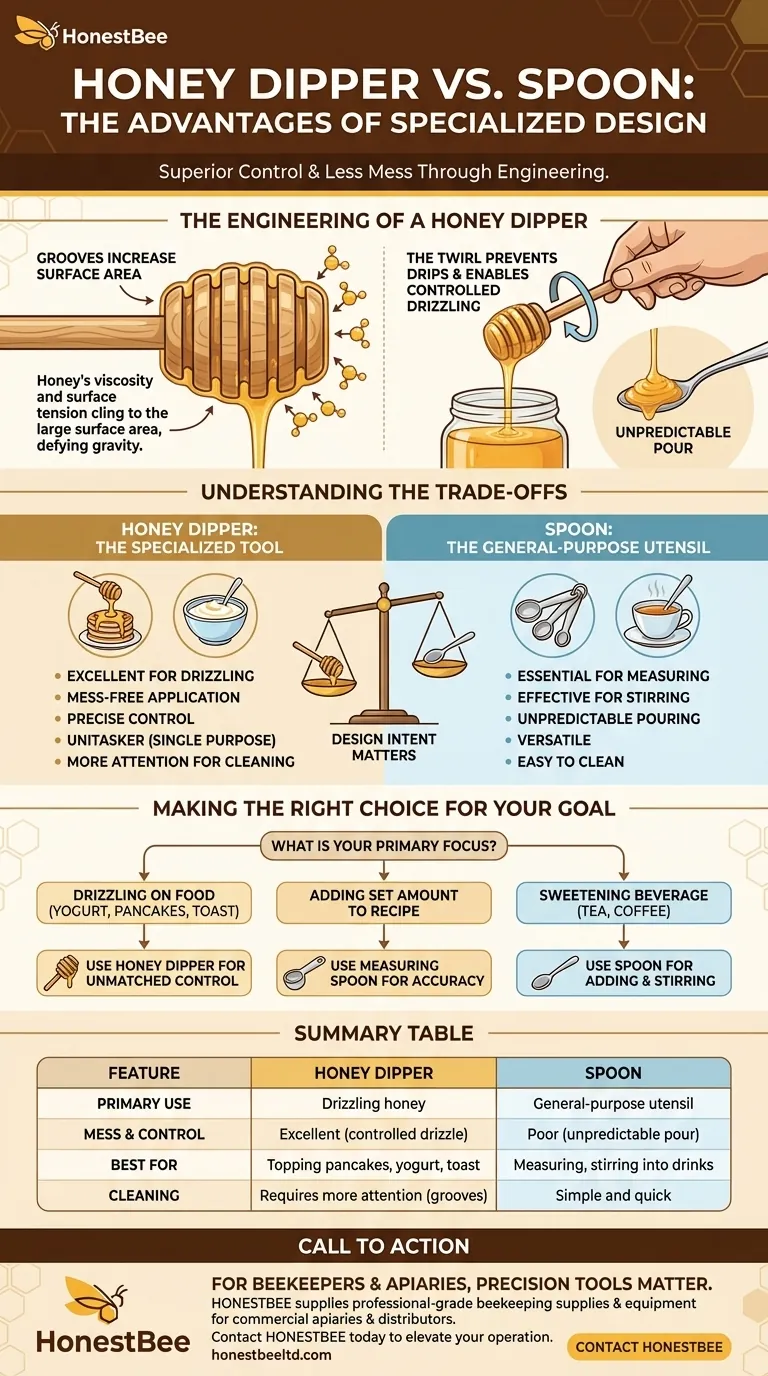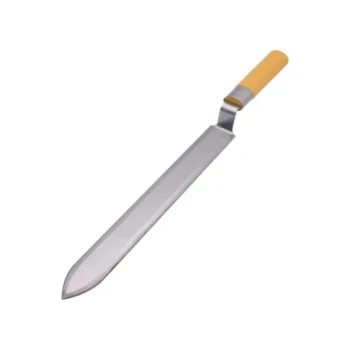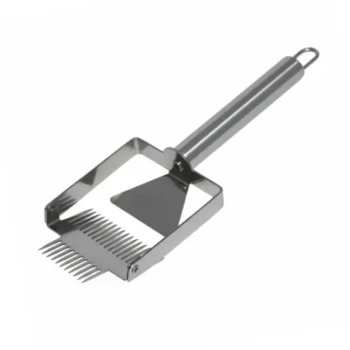In short, a honey dipper offers superior control and less mess compared to a spoon. Its unique design is engineered specifically to work with the thick, viscous nature of honey. While a spoon simply acts as a small bowl, a dipper uses its grooves to trap the honey, allowing for a clean transfer and a controlled, even drizzle that a spoon cannot match.
The core difference is one of design intent. A spoon is a general-purpose utensil that struggles with honey's properties, leading to drips and mess. A honey dipper is a specialized tool that leverages honey's viscosity to its advantage, enabling precision and cleanliness.

The Engineering of a Honey Dipper
To understand the dipper's advantage, you have to look at how its form interacts with the physical properties of honey. It's a simple tool, but its design is rooted in fluid dynamics.
How Grooves Defeat Gravity
The defining feature of a honey dipper is its series of horizontal grooves or channels. These grooves significantly increase the tool's surface area.
Honey is a viscous liquid, meaning it resists flowing. This property, combined with its natural surface tension, allows it to cling effectively to the large surface area created by the grooves, temporarily defying gravity.
The Power of the Twirl
When you lift a loaded dipper from the jar, you give it a slow twirl. This simple action is critical.
The rotational motion continuously wraps the outer layer of honey around the dipper, preventing gravity from pulling it downwards into a drip. This allows you to move the honey from the jar to your cup or toast without leaving a sticky trail behind.
Controlled Drizzling vs. Unpredictable Pouring
With a spoon, honey pools in the basin and falls off in an unpredictable glob. You have very little control over where it lands or how much is dispensed.
A honey dipper provides precision. By holding it horizontally over your food and stopping the twirl, the honey is released in a fine, consistent stream as it flows out of the grooves. A slight rotation gives you stop-and-start control over the drizzle.
Understanding the Trade-offs
While a honey dipper excels at its specific job, it is not universally superior to a spoon. Choosing the right tool requires acknowledging their respective limitations.
The Spoon's Advantage: Measurement and Stirring
Spoons are essential for baking and cooking because they come in standardized measurements (teaspoon, tablespoon). If a recipe calls for a specific quantity of honey, a measuring spoon is the only tool that provides that accuracy.
Furthermore, a spoon is designed to stir. It is far more effective for incorporating honey into a beverage like tea or coffee than a bulky, round dipper.
The Dipper's Limitation: A Single-Purpose Tool
A honey dipper is a classic example of a "unitasker." It is designed for one job—drizzling honey—and it does that job exceptionally well.
However, it is not useful for scooping solids, eating soup, or measuring ingredients. Its specialized nature means it occupies space for a very narrow function.
Cleaning and Storage Considerations
A smooth spoon is trivial to clean. The grooves of a honey dipper, however, can trap honey, requiring a more thorough rinse or soak to fully clean.
Many dippers are designed to be left inside the honey jar. While convenient, this can be a consideration for those concerned with long-term hygiene or potential crystallization.
Making the Right Choice for Your Goal
Selecting the correct utensil depends entirely on what you are trying to accomplish.
- If your primary focus is drizzling honey over food like yogurt, pancakes, or toast: The dipper provides unmatched control for an even, mess-free application.
- If your primary focus is adding a set amount of honey to a recipe: A standard measuring spoon is the necessary tool for accuracy and consistency.
- If your primary focus is sweetening a beverage like tea or coffee: A spoon is more practical as it allows you to both add the honey and stir it in with a single utensil.
Ultimately, understanding the purpose behind each tool's design empowers you to work more effectively in your kitchen.
Summary Table:
| Feature | Honey Dipper | Spoon |
|---|---|---|
| Primary Use | Drizzling honey | General-purpose utensil |
| Mess & Control | Excellent (controlled drizzle) | Poor (unpredictable pour) |
| Best For | Topping pancakes, yogurt, toast | Measuring, stirring into drinks |
| Cleaning | Requires more attention (grooves) | Simple and quick |
For beekeepers and apiaries, precision tools matter. Just as a honey dipper provides superior control for the end-user, HONESTBEE supplies the professional-grade beekeeping supplies and equipment that commercial apiaries and distributors need to produce high-quality honey efficiently and at scale. From extraction to bottling, our wholesale-focused operations ensure you have the right tools for the job. Contact HONESTBEE today to discuss your equipment needs and elevate your operation.
Visual Guide

Related Products
- Professional Honey Uncapping Roller for Efficient Harvesting
- Stainless Steel Pivoting Honey Uncapping Fork with Plastic Handle
- All-Stainless Steel Pivoting Honey Uncapping Fork for Beekeeping
- Adjustable Stainless Steel Honey Uncapping Fork with Scraper for Beekeeping
- Professional Bent Tine Honey Uncapping Fork with Ergonomic Grip
People Also Ask
- What is uncapping honey? Unlock the Key Step to Efficient Honey Harvesting
- What are the benefits of using an uncapping roller? Save Bee Energy and Boost Hive Productivity
- What to use to uncap honey? Choose the Right Tool for Your Apiary
- What is the advantage of an uncapping plane over an electric knife? Precision Cutting for Less Honey Waste
- What is a decapping knife used for? Unseal Honeycomb for an Efficient Harvest



















